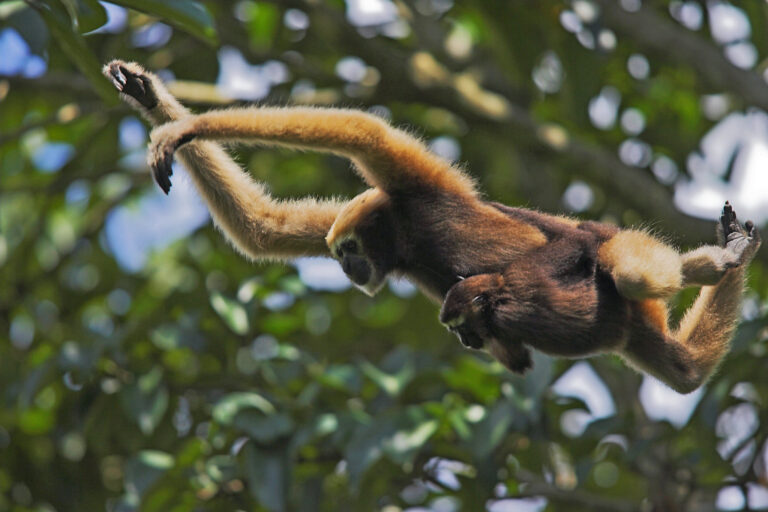Pictures of missing link between fish and land animals
Ancient missing link between fish and land animals found
University of Chicago
April 5, 2006
Paleontologists have discovered fossils of a species that provides the missing evolutionary link between fish and the first animals that walked out of water onto land about 375 million years ago. The newly found species, Tiktaalik roseae, has a skull, a neck, ribs and parts of the limbs that are similar to four-legged animals known as tetrapods, as well as fish-like features such as a primitive jaw, fins and scales.
These fossils, found on Ellesmere Island in Arctic Canada, are the most compelling examples yet of an animal that was at the cusp of the fish-tetrapod transition. The new find is described in two related research articles highlighted on the cover of the April 6, 2006, issue of Nature.
“Tiktaalik blurs the boundary between fish and land-living animal both in terms of its anatomy and its way of life,” said Neil Shubin, professor and chairman of organismal biology at the University of Chicago and co-leader of the project.
Tiktaalik was a predator with sharp teeth, a crocodile-like head and a flattened body. The well-preserved skeletal material from several specimens, ranging from 4 to 9 feet long, enabled the researchers to study the mosaic pattern of evolutionary change in different parts of the skeleton as fish evolved into land animals.
The high quality of the fossils also allowed the team to examine the joint surfaces on many of the fin bones, concluding that the shoulder, elbow and wrist joints were capable of supporting the body-like limbed animals.

Tiktaalik roseae is an intermediate between fish that lived in water and animals that evolved to walk on land. Its fin is like that of fish, but it was capable of propping the body of the animal up, much like a limb. (Artwork by Kalliopi Monoyios) A model of a newly discovered species, Tiktaalik roseae, that fills in the evolutionary gap between fish and land animals, depicted in what scientists believe to be the animal’s environment about 375 million years ago. (Model by Tyler Keillor, Photo by Beth Rooney) |
“Human comprehension of the history of life on Earth is taking a major leap forward,” said H. Richard Lane, director of sedimentary geology and paleobiology at the National Science Foundation. “These exciting discoveries are providing fossil ‘Rosetta Stones’ for a deeper understanding of this evolutionary milestone-fish to land-roaming tetrapods.”
One of the most important aspects of this discovery is the illumination of the fin-to-limb transition. In a second paper in the journal, the scientists describe in depth how the pectoral fin of the fish serves as the origin of the tetrapod limb.
Embedded in the fin of Tiktaalik are bones that compare to the upper arm, forearm and primitive parts of the hand of land-living animals.
“Most of the major joints of the fin are functional in this fish,” Shubin said. “The shoulder, elbow and even parts of the wrist are already there and working in ways similar to the earliest land-living animals.”
At the time that Tiktaalik lived, what is now the Canadian Arctic region was part of a landmass that straddled the equator. It had a subtropical climate, much like the Amazon basin today. The species lived in the small streams of this delta system. According to Shubin, the ecological setting in which these animals evolved provided an environment conducive to the transition to life on land.
“We knew that the rocks on Ellesmere Island offered a glimpse into the right time period and the right ancient environments to provide the potential for finding fossils documenting this important evolutionary transition,” said Ted Daeschler of the Academy of Natural Sciences in Philadelphia, a co-leader of the project. “Finding the fossils within this remote, rugged terrain, however, required a lot of time and effort.”
The nature of the deposits where the fossils were found and the skeletal structure of Tiktaalik suggests the animal lived in shallow water and perhaps even out of the water for short periods.
“The skeleton of Tiktaalik indicates that it could support its body under the force of gravity whether in very shallow water or on land,” said Farish Jenkins, professor of organismic and evolutionary biology at Harvard University and co-author of the papers. “This represents a critical early phase in the evolution of all limbed animals, including humans — albeit a very ancient step.”
The new fossils were collected during four summers of exploration in Canada’s Nunavut Territory, 600 miles from the North Pole, by paleontologists from the Academy of Natural Sciences in Philadelphia, the University of Chicago and Harvard University. Although the team has amassed a diverse assemblage of fossil fish, Shubin said, the discovery of these transitional fossils in 2004 was a vindication of their persistence.
The scientists asked the Nunavut people to propose a formal scientific name for the new species. The Elders Council of Nunavut, the Inuit Qaujimajatuqangit, suggested “Tiktaalik” (tic-TAH-lick) — the word in the Inuktikuk language for “a large, shallow water fish.”
The scientists worked through the Department of Culture, Language, Elders and Youth in Nunavut to collaborate with the local Inuit communities. All fossils are the property of the people of Nunavut and will be returned to Canada after they are studied.
The team depended on the maps of the Geological Survey of Canada. The researchers received permits from the Department of Culture, Language, Elders and Youth of the Government of Nunavut, and logistical support in the form of helicopters and bush planes from Polar Continental Shelf Project of Natural Resources Canada. The National Science Foundation and the National Geographic Society, along with an anonymous donor, also helped fund the project.
This is a modified news release from the University of Chicago
New Fossils Fill the Evolutionary Gap Between Fish and Land Animals
National Science Foundation Press Release 06-055
Predator has sharp teeth, a crocodile-like head and flattened body
Working in rocks more than 375 million years old far above the Arctic Circle, paleontologists have discovered a remarkable new fossil species that represents the most compelling evidence yet of an intermediate stage between fish and early limbed animals.
The new species has a skull, neck, ribs, and parts of a fin that resemble the earliest limbed animals, called tetrapods. But the creature also has fins and scales like a fish.

Fossil fish bridges evolutionary gap between animals of land and sea. Credit: Zina Deretsky, National Science Foundation |
“This animal is both fish and tetrapod. We jokingly call it a fishapod,” said Neil Shubin of the University of Chicago. He and paleontologists from the Academy of Natural Sciences in Philadelphia, the University of Chicago, and Harvard University conducted the research. They report the finding in two papers published this week in the journal Nature.
“Paleontologists have known that animals first appeared on land in the Devonian Period,” said Richard Lane, program director in the National Science Foundation (NSF)’s division of earth sciences, which funded the research. “To reach this evolutionary milestone, a skeletal progression from fish to land-roaming tetrapods would have been needed. Now we have new evidence of that progression.”
The back of the animal’s skull, neck, ribs and fins “are particularly tetrapod-like while the snout, lower jaws, and scale-cover are similar to those seen in closely related fish,” Shubin said. The animal was a predator with sharp teeth, a crocodile-like head and a flattened body.
Scientists collected the fossils during four summer explorations on Ellesmere Island in Canada’s Nunavut Territory. They turned to the people of Nunavut, who retain ownership of the fossils, for help in naming the new creature. The Nunavut Elders Council suggested the name “Tiktaalik” (tic-TA-lick), their word for a large, shallow-water fish.
At the time Tiktaalik lived, the Canadian Arctic region was part of a landmass that straddled the equator and had a subtropical climate. The deposits that produced the Tiktaalik fossils were left by stream systems meandering across wide floodplains.
“This kind of shallow stream system seems to be where many features of land-living animals first arose,” said Ted Daeschler of the Academy of Natural Sciences in Philadelphia. “The species shows that evolution from life in water to life on land happened gradually in fish in shallow water.”
The skeletal structure of Tiktaalik and the nature of the deposits where it was found suggest an animal that lived on the water bottom, in the shallows, and perhaps even out of the water for short periods.
“The skeleton of Tiktaalik indicates that it could support its body under the force of gravity whether in very shallow water or on land,” said Farish Jenkins of Harvard University. “This represents a critical early phase in the evolution of all limbed animals, including us.”
The project was also funded by the National Geographic Society, an anonymous donor, and the researchers’ institutions. The team also relied on geological mapping by the Geological Survey of Canada.
The National Science Foundation (NSF) is an independent federal agency that supports fundamental research and education across all fields of science and engineering, with an annual budget of $5.58 billion. NSF funds reach all 50 states through grants to nearly 1,700 universities and institutions. Each year, NSF receives about 40,000 competitive requests for funding, and makes nearly 10,000 new funding awards. The NSF also awards over $400 million in professional and service contracts yearly.
This is a modified news release from the National Science Foundation.














